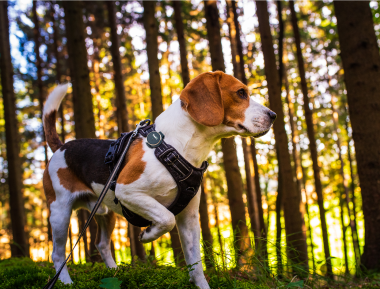Keep your furry friend in tip-top shape with a few easy-to-follow steps.
We know that your pup’s well-being is super important to you. That’s why TrackiPet has distilled the essential, reliable know-how you’ll need to keep pooch healthy and happy. Today we’re going to talk about:
- How to monitor your dog’s health
- Canine nutrition
- How to know if your dog’s getting enough exercise
- Best grooming practices
- The vet
Remember, your trusted family vet should be your #1 source for information about your dog’s health and wellness!
How to Monitor Your Dog’s Health
If you know what to look out for, you can be checking your pup’s health status all the time.
- Fur - Fur should be shiny, without any bald spots.
- Skin - Be on alert for redness, flaking, or irritation.
- Eyes - Should be bright, sparkly, and full of love! And free from redness, swelling, excessive tearing, gunk, or cloudiness.
- Mouth - Bad breath could signal dental disease. Gums should be pink and teeth should be whole and white(ish).
- Weight - Ideal dog weight varies by breed and age. In general, you should be able to feel pooch’s ribs beneath their skin easily, but bones shouldn’t protrude too much.
- Elimination - Stools should be regular, firm, and easy to pass.
- Behavior - Any significant behavior or appetite change could be a red flag.
Call the vet if you notice anything of concern.
Canine Nutrition
With so many dog food options on the market, choosing the right one can be stressful. The good news is that, in most cases, any reputable brand suitable for your dog’s age and size should be fine as long as pooch responds well to it.
Let’s talk about the doggy diet options available to you.
Conventional Dog Food
Conventional dog food is made up of a mixture of animal and plant-based ingredients. It comes in dry kibble or wet canned forms. In the United States, all dog food on the market is required to meet or exceed the standards of the Association of American Feed Control Officials (AAFCO), so it’s all safe for pup!
Then how do you pick?
First, choose an option indicated for your dog’s age and size.
Next, check out the ingredient list. The best dog foods have meat in the first two to three ingredients and few chemical preservatives and fillers.
Homemade Dog Food
Cooking your dog’s meals with love can sound so appealing! It gives you complete control over the ingredients that they’re consuming.
Ask yourself a few simple questions to determine if homemade dog food is right for you:
- Do you have time to shop, cook, and portion meals just for pooch? Your dog’s nutritional needs are different from yours and they can’t simply have a plate of the family dinner.
- Is the cost budget appropriate? A homemade diet is often cheaper than specialized dog foods, but more expensive than conventional kibble.
- How will you find recipes? Make sure to use reputable sources like Balance It when researching your pup’s nutritional needs, choosing recipes, and buying supplements.
- Does your dog have medical conditions? If so, you’ll need to adjust your recipes accordingly.
- Do you have a baseline understanding of your dog’s ideal condition? You’ll need to monitor for changes when you introduce homemade food into their diet.
If you’re ready to embark on your homemade dog food journey, we applaud you!
Raw Dog Food
Wondering if a raw food, or BARF (Biologically Appropriate Raw Food), diet may be right for your furry friend? You are not alone. Let’s look at the pros and cons.
Pros:
- Much like the Paleo diet for humans, the BARF diet is modelled after how dogs ate “in the wild.” It includes high-quality animal proteins and dog-safe fruits and veggies with no preservatives or fillers.
- Promotes healthy fur, skin, bones, joints, teeth, energy levels, and digestion.
- Contains no known canine allergens.
Cons:
- Raw animal products carry an increased risk of pathogens, like Salmonella. The American Veterinary Association does not recommend feeding pets raw animal products that have not been treated to eliminate pathogens.
- It can get pricey.
- Raw diets are grain free. That’s great if your dog has a grain allergy, but if they don’t, the lack of carbs might affect their energy levels.
Does that clear things up? We hope so!
Can my dog be vegetarian?
Technically, yes! Dogs are omnivores, which means that their bodies are able to process plant-based nutrients, including protein.
BUT to ensure pooch’s health on a plant-based diet, you’ll almost definitely need to add supplements, especially those containing taurine and L-carnatine, two amino acids that your dog’s body won’t synthesize well without consuming meat.

If your dog’s food seems to make them sick, it’s time to talk to a vet. They may have an intolerance to an ingredient or need a special diet.
How do I know if my dog is getting enough exercise?
Getting the right amount of exercise is absolutely crucial to your furry friend’s well-being. Typical physical activities include walking, jogging, swimming, and playing!
A proper exercise regime ensures:
- Healthy weight maintenance
- Mood support
- A reduction in agitated behaviors—a dog with extra energy is likely to act out!
How much exercise does my dog need?
Your dog’s breed, age, and health are the biggest factors in determining the amount of exercise they need.
Puppies have loads of energy, but they like to spend it in short bursts rather than all at once. If they don’t get a few shorter activities in during the day, they might get a case of the zoomies before bed!
Adult dogs in good health usually need at least 1-2 hours of exercise a day—or more for high-energy breeds.
It’s best to consult a vet about the best exercise regime for dogs with health conditions like obesity, heart issues, or joint pain.
How can I meet my dog’s exercise needs on a busy schedule?
With the busy modern lives we lead, it's hard to get in walks and visits to the dog park. But don’t worry; you can still meet your dog’s exercise needs without making such a huge time commitment! You can:
- Hire a walker or take pup to doggy daycare.
- Incorporate your dog into your existing exercise regime.
- Play games, like fetch, that keep your dog running without needing your full attention.
- Give your dog an interactive toy.
Best Grooming Practices
The good news is that your pooch doesn’t need the full workup at the doggy spa to stay healthy. But basic hygiene is important. Here are a few simple dog grooming steps you can take at home to keep your dog healthy.
- Regular bathing - Most breeds need a bath every 4-6 weeks. Bathing too much or too little can irritate pup’s skin.
- Nail trimming - Cutting your pup’s nails prevents them from breaking and promotes joint health.
- Teeth cleaning - Regular brushing and/or dental chews helps prevent dental disease. Ask your vet about techniques and canine-safe dental products.
However, canines with special upkeep needs like major haircuts might need professional help.
The Vet
Your relationship with your vet should begin as soon as your new dog enters your home, or even before. Research the vets in your area and make sure you find one you really click with!
Never skip pooch’s annual checkup and call the vet anytime you have questions or notice physical or behavioral changes.
Here are some of the things that you can expect to happen during your early vet visits.
Vaccines
Ideally, every dog begins vaccinations at 6-8 weeks, completes the first cycle around 16 weeks, and receives boosters throughout their lifetime.
There are core and non-core vaccines—those that are mandatory and those that are recommended or optional. Your vet can give you the breakdown, depending on your geographical area and socialization practices.
Many of the diseases that dog vaccines prevent are life-threatening and some are transmitable to humans. That’s why dog vaccination is so important!
Microchipping
A microchip is about the size of a grain of rice, very easy to place, and acts as a permanent ID for your dog. Placement is very important and can be a lifesaver if pooch ever gets lost.
Spaying and Neutering
Whether or not to sterilize your dog is a personal choice. Leaving them unsterilized can lead to unwanted pregnancies. If you’re not prepared for puppies, sterilization can be a great option.
Sterilization can also reduce unpleasant behaviors related to sexual maturity. In males, this can look like aggression, marking of territory, or wandering to find females in heat. Females may also become agitated or wander when in heat.
Talk to your vet about whether or not sterilization is right for your furry friend!
Heartworm, Flea, and Tick Prevention
Heartworm is transmitted by mosquitos and causes worms to reproduce and grow in your pup’s bloodstream. It is easy to prevent with oral medication, but difficult and costly to treat once contracted!
Fleas and ticks are a nuisance and can also transmit disease. There are many ways to prevent flea and tick attacks including drops, collars, and pills.


